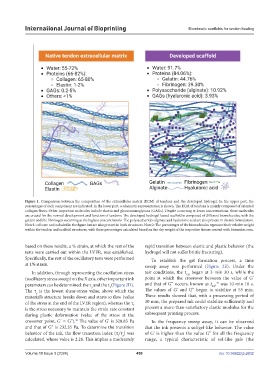Page 458 - IJB-10-3
P. 458
International Journal of Bioprinting Biomimetic scaffolds for tendon healing
Figure 1. Comparison between the composition of the extracellular matrix (ECM) of tendons and the developed hydrogel. In the upper part, the
percentages of each component are indicated. In the lower part, a schematic representation is shown. The ECM of tendons is mainly composed of oriented
collagen fibers. Other important molecules include elastin and glycosaminoglycans (GAGs). Despite occurring at lower concentrations, these molecules
are crucial for the normal development and function of tendons. The developed hydrogel-based scaffold is composed of different biomolecules, with the
gelatin and the fibrinogen occurring at the highest concentrations. The polysaccharides alginate and hyaluronic acid are also present in the ink formulation.
Note1: cells are not included in the figure but are also present in both structures. Note2: The percentages of the biomolecules represent their relative weight
within the tendon and scaffold structures, with these percentages calculated based on the dry weight of the respective tissues created with biorender.com.
based on these results, a % strain, at which the rest of the rapid transition between elastic and plastic behavior (the
tests were carried out within the LVER, was established. hydrogel will not suffer brittle fracturing).
Specifically, the rest of the oscillatory tests were performed To establish the gel formation process, a time
at 1% strain. sweep assay was performed (Figure 2E). Under the
In addition, through representing the oscillation stress test conditions, the t began at 3 min 30 s, while the
CR
(oscillatory stress sweep) on the X axis, other important ink point at which the crossover between the value of G’
49
parameters can be determined: the τ and the τ (Figure 2D). and that of G’’ occurs, known as t , was 10 min 10 s.
SG
f
y
The τ is the lowest shear-stress value, above which the The values of G’ and G’’ began to stabilize at 55 min.
y
material’s structure breaks down and starts to flow (value These results showed that, with a processing period of
of the stress at the end of the LVER region), whereas the τ f 30 min, the prepared ink could stabilize sufficiently and
is the stress necessary to maintain the strain rate constant present a more-than-satisfactory elastic modulus for the
during plastic deformation (value of the stress at the subsequent printing process.
crossover point, G’ = G’’). The value of G’ is 528.83 Pa In the frequency sweep assay, it can be observed
48
and that of G’’ is 232.35 Pa. To determine the transition that the ink presents a sol/gel-like behavior. The value
behavior of the ink, the flow transition index (τ /τ ) was of G’ is higher than the value G’’ for all the frequency
f
y
calculated, whose value is 2.28. This implies a moderately range, a typical characteristic of sol-like gels (the
Volume 10 Issue 3 (2024) 450 doi: 10.36922/ijb.2632

